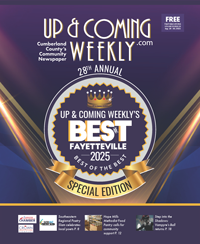Library's Cumberland Cooks increases culinary literacy
- Details
- Tuesday, 16 December 2025
- Written by Sheila D. Barker

 Cumberland County Public Library is transforming the way residents engage with food, nutrition, and lifelong wellness through its new Cumberland Cooks program. Launched in September, this culinary literacy initiative uses fully equipped Charlie Cart mobile kitchens to deliver hands-on cooking classes, live demonstrations, and wellness-focused education across multiple library branches.
Cumberland County Public Library is transforming the way residents engage with food, nutrition, and lifelong wellness through its new Cumberland Cooks program. Launched in September, this culinary literacy initiative uses fully equipped Charlie Cart mobile kitchens to deliver hands-on cooking classes, live demonstrations, and wellness-focused education across multiple library branches.
With a mission to combat food insecurity and increase food literacy, Cumberland Cooks is opening doors for community members of all ages to build practical, healthy cooking skills—entirely free of charge.
At its core, Cumberland Cooks is designed to make healthy, affordable cooking accessible to everyone. The program teaches fundamental skills, such as knife safety, budgeting for groceries, interpreting nutrition labels, and preparing balanced meals.
Participants not only learn how to cook but also gain a deeper understanding of why food literacy matters—especially in a county where food deserts and food insecurity affect many families. The library’s focus on outcomes-based instruction ensures that each session equips attendees with knowledge they can immediately apply at home.
The heart of the program is the library’s two new Charlie Carts, state-of-the-art mobile kitchens funded by a $40,500 grant from the Institute of Museum and Library Services.
Each cart includes a convection oven, induction cooktop, sink, and storage for more than 100 kitchen tools, allowing staff to deliver high-quality cooking programs anywhere. The carts rotate among CCPL’s eight locations, spending two months at each branch so the entire community has consistent access to hands-on culinary learning.
These portable teaching kitchens make it possible for CCPL staff to bring dynamic cooking experiences directly to neighborhoods across Fayetteville and Cumberland County. Sessions vary by branch and audience, with events held at locations such as Headquarters Library, West Regional Library, and East Regional Library.
The program serves multiple age groups, offering targeted events for teens, adults, and families, ensuring everyone from beginners to budding home chefs can participate.
Cumberland Cooks classes are intentionally fun, interactive, and seasonal, blending practical skills with creative cooking activities. Recent and upcoming programs include making Chocolate Chip Cookie Jars, gingerbread, and a variety of savory dips. Whether attendees are mixing dough, experimenting with spices, or learning how to stretch ingredients into multiple meals, each event reinforces the message that nutritious cooking can be both enjoyable and achievable. To see more Cumberland Cooks events, visit their calendar at
https://bit.ly/4oPgk55
Participants can expect two main types of experiences: hands-on cooking classes, where they actively prep and cook food with guidance from trained library staff, and live demonstrations, which allow attendees to watch, taste, and learn techniques they can recreate at home. Tastings provide opportunities to sample healthy dishes and explore new ingredients—an important step in expanding food awareness, especially for families on tight budgets.
Beyond teaching recipes, Cumberland Cooks fulfills a broader mission: promoting wellness and empowering residents with life skills that extend far beyond the library’s walls. By integrating concepts like food safety, meal planning, and cultural cuisine, the program encourages a deeper appreciation for nourishing foods and the role they play in overall well-being.
For teens and young adults, these classes provide essential skills that support independence and long-term health.
Cumberland Cooks is redefining what a public library can be. With mobile kitchens, grant-funded resources, and a commitment to community wellness, CCPL is creating a vibrant space where residents can learn to cook healthy, affordable meals—one recipe at a time. In doing so, the library is not just a place for books, but a hub for practical skills, shared learning, and lasting nourishment.
(Photo: The Charlie Carts at the library were provided by a grant from the Institute of Museum and Library Services. The carts are mobile kitchens, and allow for easier culinary instruction. Photo courtesy of the Charlie Cart Project's Facebook page)

 How to resolve AdBlock issue?
How to resolve AdBlock issue? 












